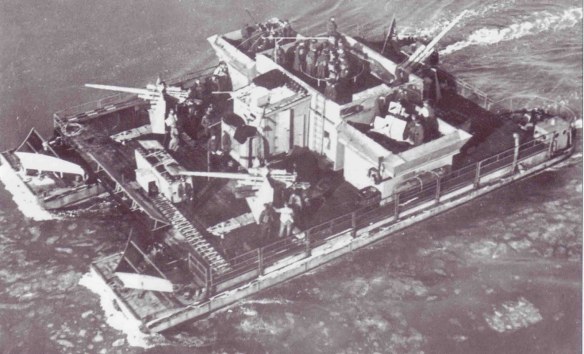
Siebelfähre flak barge
The Siebel ferry (Siebelfähre) was a shallow-draft catamaran landing craft operated by Germany’s Wehrmacht during World War II. It served a variety of roles (transport, flak ship, gunboat, convoy escort, minelayer) in the Mediterranean, Baltic and Black Seas as well as along the English Channel. They were originally developed for Operation Sea Lion, Germany’s planned but never-executed 1940 invasion of England. Siebel ferries continued performing useful service even after the war’s end in 1945.
Series production of the Siebel ferry began in September 1940 at Antwerp as a joint Army-Luftwaffe venture with the Army’s Böndel Pionier-Sonderkommando (Engineer Special Command) assembling the pontoons, decking and water propulsion while Col. Siebel’s Luftwaffe-Sonderkommando installed the auxiliary surplus aircraft engines. By late September twenty-five of these craft had been completed.
For Operation Sea Lion, the Luftwaffe organized the Siebel ferries into two flotillas: Flakkorps I (assigned to 9th Army) and Flakkorps II (assigned to 16th Army). They were intended to provide flank defense against air, ground and surface targets for the First Wave tow formations. Each Siebel ferry would transport a complete flak unit consisting of one 8.8 cm gun and two 2 cm guns plus their three prime movers (although 9th Army planned to transport the necessary towing vehicles and support personnel separately via barges). Upon reaching the invasion beaches, the ferries were to land their flak units and then assist with unloading the larger steamers anchored offshore. The Army rather disingenuously referred to the Siebel ferries as “destroyer substitutes”.
With its simplicity of design, sturdy construction, good seakeeping and the ease with which it could be disassembled and shipped via rail to virtually any point on the Continent, the Siebel ferry proved a highly useful and adaptable amphibious vessel for transporting troops, vehicles and supplies across open water wherever needed by German forces. It was also easily configured to serve a variety of special purposes, from minelaying to convoy escort.The Seibel ferries not only provided solutions for a broad variety of roles for the German armed forces, but caused the Allies tactical problems in dealing with them. Notwithstanding their often dangerous firepower, they were virtually immune to torpedo attacks, as these weapons usually passed harmlessly under their shallow draft pontoons.
The Siebel ferries were built in different versions:
Siebelfähre 40 Siebel Ferry 40
* Verdrängung: 130 t Displacement: 130 t
* Länge: 21,6 m Length: 21.6 m
* Breite: 13,9 m Width: 13.9 m
* Tiefgang: 1,2 m Draft: 1.2 m
* Kapazität: 150 Mann Capacity: 150 men
* Antrieb: 2x 75 PS, 3 x BMW-Flugzeugmotoren 300 PS Power: 2x 75 hp, 3 x BMW aircraft engines 300 hp
* Höchstgeschwindigkeit: 6,5 kn Maximum speed: 6.5 kn
Siebelfähre 41 Siebel Ferry 41
* Verdrängung: 130 t Displacement: 130 t
* Länge: 24,3 m Length: 24.3 m
* Breite: 13,9 m Width: 13.9 m
* Tiefgang: 1,2 m Draft: 1.2 m
* Kapazität: 250 Mann Capacity: 250 men
* Antrieb: 1 BMW-6-Motor, 210 PS Drive: BMW 1-6 engine, 210 hp
* Höchstgeschwindigkeit: 6,5 kn Maximum speed: 6.5 kn
Siebelfähre 43 Siebel Ferry 43
* Verdrängung: 143 t Displacement: 143 t
* Länge: 32,0 m Length: 32.0 m
* Breite: 14,7 m Width: 14.7 m
* Tiefgang: 1,75 m Draft: 1.75 m
* Kapazität: 169 t Capacity: 169 t
* Antrieb: 2x 280 PS, BMW Power: 2x 280 hp, BMW
* Höchstgeschwindigkeit: 5,4 kn Maximum speed: 5.4 kn
Siebelfähre 44 Siebel Ferry 44
* Verdrängung: 130 t Displacement: 130 t
* Länge: 26,0 m Length: 26.0 m
* Breite: 13,7 m Width: 13.7 m
* Tiefgang: 0,9 m Draft: 0.9 m
* Kapazität: 169 t Capacity: 169 t
* Antrieb: 2x 280 PS, BMW Power: 2x 280 hp, BMW
* Höchstgeschwindigkeit: 7,4 kn Maximum speed: 7.4 kn
Marinefahrprahm [MFP’s] were made assembled from sections, once welded together; the craft could not be disassembled.
There was a way to transport MFP on roads using special trailers and powerful tractors. Over 80 were transported through France in that fashion, 50 through Germany to the Danube for use in the Black Sea, and more through Italy and the like.
The major obstacle to bring Germany built craft to the Mediterranean was the narrow channels of France. The route was Rhine, Rhine-Rhone channel, Rhone. In January 1944 the first MNL (Marine Nachschub Leichter – navy supplies lighter) was delivered which with its width of 5150mm could travel this way. This was the reason for its construction. MFPs could not.
MAL (Marine Artillerie Leichter) were made of 9 rail transportable sections that were riveted together. They could thus be disassembled.